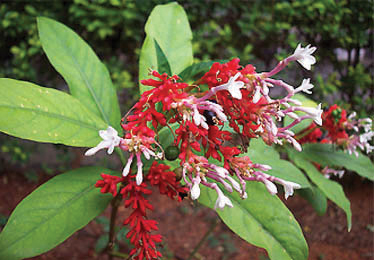Sarpagandha (Rauwolfia serpentina)
Sarpagandha is known as Dhawal barua in Hindi and Serpentine wood in English. It belongs to family Apocynaceae and Kutaj kul in Ayurveda. This plant is native to the moist, deciduous forests of southeast Asia including India, Burma, Bangladesh, Sri Lanka, and Malaysia. The plant was mentioned in Indian manuscripts approximately 1,000 BC as Sarpagandha and Chandrika. The genus Rauwolfia was named in honor of a German physician Dr. Leonhard Rauwolf, who studied this plant while traveling in India in the 16th century. The Indian physician Rustom Jal Vakil published his studies on the antihypertensive properties of R. serpentina in the British Medical Journal in 1949 and introduced this plant to the Western world.
Plant description: The plant usually grows to a height between 60 and 90 cm and has pale green leaves that are 7 to 10 cm long and 3.5 to 5.0 cm wide. The leaves are elliptical or lanceolate shaped and occur in whorls of 3 to 5 leaves. The plant has many shiny, black or purple, round fruits that are approximately 0.5 cm in diameter. It also has small pink or white flowers. The plant has a prominent tuberous, soft taproot that reaches a length between 30 and 50 cm and a diameter between 1.2 and 2.5 cm.
Ayurvedic pharmacology: Guna-Ruksha, Rasa-Tikta, Vipaak-Katu, Veerya-Ushna, Prabhaav-Nidrajanan
Chemical composition: The plant contains approximately 200 alkaloids of the indole alkaloid family. The major alkaloids are ajmaline, ajmalicine, ajmalimine, deserpidine, indobine, indobinine, reserpine, reserpiline, rescinnamine, rescinnamidine, serpentine, serpentinine and yohimbine. All parts of the plant, including the stem and leaves, contain indole alkaloids, but they are found in highest concentration in the bark of the root. Reserpine is the most widely used alkaloid found in this plant.
Therapeutically useful part: Root.
Therapeutic uses: This is mostly used to treat hypertension. Other uses are to treat snake and insect bites, febrile conditions, malaria, abdominal pain, dysentery, fever and schizophrenia.
Doses: Varies from 1 gram to 4 grams/day in divided doses according to disease and person.
Side effects: Depression, slow heart rate, and dizziness are the main side effects. The medicine should be taken in physician’s close supervision.
Dr. Pratibha Mamgain, Dept. of Ayurvedic Medicine

